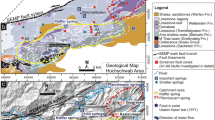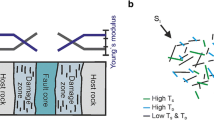Abstract
The Cenozoic activity of the De Geer transform fault, which releases the relative movements between of the North Atlantic and the Arctic Ocean, produced a wide deformation zone that presently affects the western coast of the Svalbard (Spitsbergen Island) as testified in the extended rock exposure along the West Spitsbergen fold and thrust belt. In particular, the still ongoing tectonic activity along this transform is responsible for the formation of fault strands characterized by highly fractured damage zones (DZs). These DZs represent hydraulic conduit that steer the pathway of deep fluids (e.g., oil and gas). Understanding the fracturing evolution in fault DZs represent a key factor to model potential reservoirs in the arctic region (and in the Barents Sea area) for various purposes including natural resources development (oil/gas production), gas storage (CO2) as well as nuclear waste disposal. In the present work, we analyze two faults representative of the status of brittle deformation of Vendian carbonates in Svalbard where it was possible to study the fracturing in their DZ. The intensity of brittle deformation was quantified and its spatial variation within the DZ was modeled through an empirical/physical approach that allowed to develop a predictive model to quantify fracturing. This model was prepared by comparing field measurements with an empirical equation taking into account the main fracturing and sealing processes operating during the fault activity. Results can be successfully applied to other carbonate rocks, including the Svalbard analogues of the carbonate reservoirs in the Barents Sea.










Similar content being viewed by others
References
Agosta F, Alessandroni M, Antonellini M, Tondi E, Giorgioni M (2010) From fractures to flow: a field-based quantitative analysis of an outcropping carbonate reservoir. Tectonophysics 490:197–213. doi:10.1016/j.tecto.2010.05.005
Belisario F, Del Monte M, Fredi P, Funiciello R, Lupia Palmieri E, Salvini F (1999) Azimuthal analysis of stream orientations to define regional tectonic lines. In: Fourth international geomorphology conference, Bologna. Zeitschrift fur Geomorphologie, Suppl.-Bd 118, pp 41–63. ISSN: 0372-8854
Bergh SG, Braathen A, Andresen A (1997) Interaction of basement-involved and thin-skinned tectonism in the Tertiary fold–thrust belt of central Spitsbergen, Svalbard. AAPG Bull 81:637–661
Billi A, Salvini F (2003) Development of systematic joints in response to flexure related fibre stress in flexed foreland plates: the Apulian forebulge case history, Italy. J Geodyn 36:523–536
Billi A, Salvini F, Storti F (2003) The damage zone–fault core transition in carbonate rocks: implications for fault growth, structure and permeability. J Struct Geol 25:1779–1794. doi:10.1016/S0191-8141(03)00037-3
Bird KJ, Charpentier RR, Gautier DL, Houseknecht DW, Klett TR, Pitman JK, Moore TE, Schenk CJ, Tennyson ME, Wandrey CJ (2008) Circum-arctic resource appraisal; estimates of undiscovered oil and gas north of the Arctic Circle. U.S. Geological Survey Fact Sheet 2008-3049, p 4. http://pubs.usgs.gov/fs/2008/3049/
Birkenmajer K (1975) Caledonides of Svalbard and plate tectonics. Bull Geol Soc Den 24(1):19
Blinova M, Faleide JI, Gabrielsen RH, Mjelde R (2012) Seafloor expression and shallow structure of a fold-and-thrust system, Isfjorden, west Spitsbergen. Polar Res 31:11209. doi:10.3402/polar.v31i0.11209
Bouysse P, Commission for the Geological Map of the World (2009) Geological Map of the World at 1:50000000. Sheet 2: geology, structure, 3rd edn. Commission for the Geological Map of the World, CCGM/CGMW, Paris
Caine JS, Evans JP, Forster CB (1996) Fault zone architecture and permeability structure. Geology 24:1025–1028
Cianfarra P, Salvini F (2014) Ice sheet surface lineaments as nonconventional indicators of East Antarctica bedrock tectonics. Geosphere 10(6):1411–1418. doi:10.1130/GES01074.1
Cianfarra P, Salvini F (2015) Lineament domain of regional strike–slip corridor: insight from the Neogene transtensional De Geer transform fault in NW Spitsbergen. Pure Appl Geophys 171:1–17. doi:10.1007/s00024-014-0869-9
Cianfarra P, Forieri A, Salvini F, Tabacco IE, Zirizotti A (2009) Geological setting of the Concordia Trench-Lake system in East Antarctica. Geophys J Int. ISSN: 0956-540X
Dallmann WK (ed) (1999) Lithostratigraphic lexicon of Svalbard. Norwegian Polar Institute, Tromsø
Dallmann WK (2007) Geology of Svalbard. In: Sigmond E, Roberts D (eds) Geology of the land and sea areas of northern Europe. Norges Geologiske Undersøkelse Special Publication 10, Geological Survey of Norway, Trondheim, pp 87–89
Dallmann WK, Andersen A, Bergh SG, Maher HD Jr, Ohta Y (1993) Tertiary fold-and-thrust belt of Spitsbergen Svalbard. Norsk Polarinstitutt Meddelelser 128:5–46
Dorè AG (1995) Barents Sea geology, petroleum resources and commercial potential. Arctic 48(3):207–221
Engen Ø, Faleide JI, Dyreng TK (2008) Opening of the Fram Strait gateway—a review of plate tectonic constraints. Tectonophysics 450:51–69
Faleide JI, Tsikalas F, Breivik AJ, Mjelde R, Ritzmann O, Engen Ø, Wilson J, Eldholm O (2008) Structure and evolution of the continental margin off Norway and the Barents Sea. Episodes 31:82–91
Fossen H, Dallman W, Andresen A (2008) The mountain chain rebounds and founders. The Caledonides are worn down: 405–359 million years. In: Ramberg IB et al (eds) The making of a land. Geology of Norway. Geological Society of Norway, Trondheim, pp 232–259
Friend PF, Moody-Stuart GM (1972) Sedimentation of the Wood Bay Formation (Devonian) of Spitsbergen: regional analysis of a late orogenic basin. Norsk Polarinstitutt Skrifter 157. Norwegian Polar Institute, Oslo
Gaina C, Gernigon L, Ball P (2009) Palaeocene-recent plate boundaries in the NE Atlantic and the formation of the Jan Mayen microcontinent. J Geol Soc 166:601–616
Gee DG, Fossen H, Henriksen N, Higgins AK (2008) From the early Paleozoic platforms of Baltica and Laurentia to the Caledonide orogen of Scandinavia and Greenland. Episodes 31:4451
Harland WB (1959) The Caledonian sequence in Ny Friesland, Spitsbergen. Q J Geol Soc Lond 114:307–342
Harland WB (1969) Contribution to the evolution of the North Atlantic region. In: Kay M (ed) North Atlantic: geology and continental drift, a symposium; papers. American Association of Petroleum Geologists, Tulsa, pp 817–857
Harland WB (1985) Caledonide Svalbard. In: Gee DG, Sturt BA (eds) The Caledonide orogen—Scandinavia and related areas. Wiley, Chichester, pp 999–1016
Harland WB (1997) Svalbard’s geological frame. In: Harland WB (ed) The geology of Svalbard, geological survey memoir 17. The Geological Society London, UK, pp 23–44
Hjelle A (1993) Geology of Svalbard. Polarhandbok 7. Norwegian Polar Institute, Oslo
Jakobsson M, Mayer LA, Coakley B, Dowdeswell JA, Forbes S, Fridman B, Hodnesdal H, Noormets R, Pedersen R, Rebesco M, Schenke HW, Zarayskaya YA, Accettella D, Armstrong A, Anderson RM, Bienhoff P, Camerlenghi A, Church I, Edwards M, Gardner JV, Hall JK, Hell B, Hestvik OB, Kristoffersen Y, Marcussen C, Mohammad R, Mosher D, Nghiem SV, Pedrosa MT, Travaglini PG, Weatherall P (2012) The International Bathymetric Chart of the Arctic Ocean (IBCAO) Version 3.0, Geophys Res Lett 39:L12609. doi:10.1029/2012GL052219
Korneva I, Tondi E, Agosta F, Rustichelli A, Spina V, Bitonte R, Di Cuia R (2014) Structural properties of fractured and faulted Cretaceous platform carbonates, Murge Plateau (southern Italy). Mar Pet Geol 57:312–326
Leever KA, Gabrielsen RH, Faleide JI, Braathen A (2011) A transpressional origin for the West Spitsbergen fold-and-thrust belt: insight from analog modeling. Tectonics 30:TC2014. doi:10.1029/2010TC002753
Maggi M, Cianfarra P, Salvini F (2013) The role of fault surface geometry in the evolution of the fault deformation zone: comparing modeling with field example from the Vignanotica normal fault (Gargano, Southern Italy). In: Geophysical research abstracts, vol 15, EGU2013, 2013, p 13937
Maggi M, Cianfarra P, Salvini F, CoelhodeLima C (2015) Staircase fractures in microbialites and the role of lamination-related mechanical anisotropy: the example of the Acquasanta Terme travertine deposits (central Italy). Soc Am Bull, Geol. doi:10.1130/B31163.1
Maggi M, Cianfarra P, Salvini F (2016) Erosion by tectonic carving in the Concordia subglacial fault zone, East Antarctica. Earth Planet Sci Lett 433(2016):99–108. doi:10.1016/j.epsl.2015.10.045
Mannino I (2012) The evolution of fracturing processes in fault damage-zones and its influence on the rock permeability: case study of the shallow marine and ramp carbonates of Central Apennines (Italy). PhD thesis, Roma Tre University, Italy, p 213
Murashov LG, Mokin JI (1979) Stratigraphic subdivision of the Devonian deposits of Spitsbergen. Norsk Polarinstitutt Skrifter 167:249–261
Ohta Y (1992) Recent understanding of the Svalbard basement in the light of new radiometric age determinations. In: Dallmann WK, Andresen A, Krill A (eds) Post-Caledonian tectonic evolution of Svalbard, vol 72. Norsk Geologisk Tidsskrift, pp 1–6
Pischiutta M, Salvini F, Fletcher J, Rovelli A, Ben-Zion Y (2012) Horizontal polarization of ground motion in the Hayward fault zone at Fremont, California: dominant fault-high-angle polarization and fault-induced cracks. Geophys J Int 188:1255–1272. doi:10.1111/j.1365-246X.2011.05319.x
Ritzmann O, Jokat W, Czuba W, Guterch A, Mjelde R, Nishimura Y (2004) A deep seismic transect from Hovgård Ridge to northwestern Svalbard across the continental-ocean transition: a sheared margin study. Geophys J Int 157:683–702
Pischiutta M, Anselmi M, Cianfarra P, Rovelli A, Salvini F (2013) Directional site effects in a non-volcanic gas emission area (Mefite d’Ansanto, southern Italy): evidence of a local transfer fault transversal to large NW-SE extensional faults? Phys Chem Earth 63:116–123. ISSN: 1474-7065 2013
Saalmann K, Thiedig F (2001) Tertiary West Spitsbergen fold and thrust belt on Brøggerhalvøya, Svalbard: structural evolution and kinematics. Tectonics 20(6):976–998
Salvini F (1991) Considerazioni sull’assetto tettonico crostale lungo il profilo CROP 03 da analisi dei lineamenti telerilevati. Studi Geologici Camerti volume speciale 1991(1):99–107
Salvini (2013) The fault zone deformation architecture. In: 40th Workshop of the international school of geophysics on the properties and processes of crustal fault zones, Erice, Italy, May 18–24, 2013. ftp://ingv.it/pro/web_ingv/Erice2013_40th%20Course.pdf/Salvini_Erice2013.pdf
Salvini F, Billi A, Wise DU (1999) Strike–slip fault-propagation cleavage in carbonate rocks: the Mattinata fault zone, southern Apennines, Italy. J Struct Geol 21:1731–1749. doi:10.1016/S0191-8141(99)00120-0
Sibson RH (1977) Fault rock s and fault mechanisms. Geol Soc Lond J 133:191–231
Storti F, Billi A, Salvini F (2003) Particle size distributions in natural carbonate fault rocks: insights for non-self-similar cataclasis. Earth Planet Sci Lett 206:173–186
Storti F, Salvini F, McClay K (1997) Fault-related folding in sandbox analogue models of thrust wedges. J Struct Geol 19(3–4):583–602
Talwani M, Eldholm O (1977) Evolution of the Norwegian Greenland Sea. Geol Soc Am Bull 88:969–999
Tessensohn F, Piepjohn K (2000) Eocene compressive deformation in Arctic Canada, North Greenland and Svalbard and its plate tectonic causes. Polarforschung 68:121–124
Tondi E, Rustichelli A, Cilona A, Balsamo F, Storti F, Napoli G, Agosta F, Renda P, Giorgioni M (2016) Hydraulic properties of fault zones in porous carbonates, examples from central and southern Italy. Ital J Geosci 135(Special Issue on “Fractured carbonate reservoirs and fluid flow”):68–79
Turcotte DL, Schubert G (2002) Geodynamics, 2nd edn. Cambridge University Press, Cambridge, p 456
Walsh JJ, Watterson J (1988) Analysis of the relationship between displacements and dimensions of faults. J Struct Geol 10(3):239–247
Wise DU, McCrory TA (1982) A new method of fracture analysis: azimuth versus distance plots. Geol Soc Am Bull 93:889–897. doi:10.1130/0016-7606(1982)93<889:ANMOFA>2.0.CO;2
Wise DU, Funiciello R, Parotto M, Salvini F (1985) Topographic lineament swarms: clues to their origin from domain analysis of Italy. Geol Soc Am Bull 96:952–967
Worsley D (2008) The post-Caledonian development of Svalbard and the western Barents Sea. Polar Res 27:298–317
Worsley D, Aga OJ (1986) The geological history of Svalbard: evolution of an Arctic archipelago. Statoil, Stavanger
Acknowledgments
The fieldwork benefitted from the facilities provided by the CNR-Base Dirigibile Italia at Ny Alesund. The authors are indebted both to the CNR and to its personnel at the base. We thank reviewers for insightful comments that improved the manuscript.
Author information
Authors and Affiliations
Corresponding author
Additional information
This peer-reviewed article is a result of the multi and interdisciplinary research activities based at the Arctic Station “Dirigibile Italia”, coordinated by the “Dipartimento Scienze del Sistema Terra e Tecnologie per l’Ambiente” of the National Research Council of Italy.
Rights and permissions
About this article
Cite this article
Cianfarra, P., Salvini, F. Quantification of fracturing within fault damage zones affecting Late Proterozoic carbonates in Svalbard. Rend. Fis. Acc. Lincei 27 (Suppl 1), 229–241 (2016). https://doi.org/10.1007/s12210-016-0527-5
Received:
Accepted:
Published:
Issue Date:
DOI: https://doi.org/10.1007/s12210-016-0527-5




